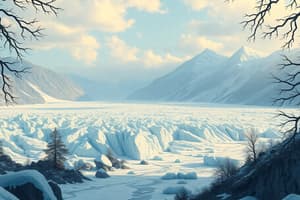Podcast
Questions and Answers
What is glacier retreat?
What is glacier retreat?
The process where a glacier loses ice mass and its terminus moves back from its previous position.
What is mitigation in the context of climate change?
What is mitigation in the context of climate change?
The action of reducing the severity or seriousness of climate change.
What does adaptation refer to in climate change?
What does adaptation refer to in climate change?
Adjustments and changes made to manage the impacts of climate change.
What does IPPC stand for?
What does IPPC stand for?
What are some drivers of sea levels rising?
What are some drivers of sea levels rising?
What does SSP stand for?
What does SSP stand for?
What is the CMIP?
What is the CMIP?
What is a carbon sink?
What is a carbon sink?
What does RCP stand for?
What does RCP stand for?
What is energy?
What is energy?
What is radiative forcing?
What is radiative forcing?
What is the photosphere?
What is the photosphere?
What is the convective zone within the Sun?
What is the convective zone within the Sun?
What does wavelength refer to?
What does wavelength refer to?
According to Wien's Displacement Law, max = b/T, where b is a constant equal to _____ mm/K.
According to Wien's Displacement Law, max = b/T, where b is a constant equal to _____ mm/K.
According to Stefan-Boltzmann Law, F = ___ T^4.
According to Stefan-Boltzmann Law, F = ___ T^4.
What are sunspots?
What are sunspots?
Study Notes
Glacier Retreat
- Glacier retreat occurs when the rate of ice melting and sublimation (ice transforming directly into water vapor) surpasses the rate of ice accumulation from snowfall.
- This leads to a loss of ice mass and the glacier's terminus (the end) moves back from its previous position.
Mitigation
- Actions taken to reduce the severity of climate change.
- Examples include:
- Hydropower
- Regulations
- Solar and wind power (reducing greenhouse gas emissions)
Adaptation
- Adjustments and changes made to manage the impacts of climate change and reduce vulnerability to its effects.
- Examples include:
- Flood defenses
- Water conservation
IPCC (Intergovernmental Panel on Climate Change)
- Composed of 195 member countries.
- Does not conduct original research, but publishes a consensus on existing research regarding climate change.
Drivers of Sea Level Rise
- Several factors contribute to rising sea levels, including:
- Thermometric expansion (water expanding as it warms)
- Melting of Greenland and glaciers
- Changes in land water storage
- Ocean dynamics
- Glacial Isostatic Adjustment (GIA) - gradual movement of Earth's crust
SSP (Shared Socioeconomic Pathways)
- Scenarios used in climate change research to explore future developments in society, their impacts on climate change, and mitigation/adaptation efforts.
- SSP 1-1.9 represents the most optimistic scenario while SSP 5-8.5 represents the worst-case scenario.
CMIP (Coupled Model Intercomparison Project)
- A project involving 33 modeling groups in 16 countries.
- Aims to compare and evaluate climate models, improving our understanding of climate change.
Carbon Sinks
- Anything that absorbs more carbon dioxide than it emits.
- Examples include plants and oceans.
RCP (Representative Concentration Pathways)
- Scenarios utilized in climate change research to forecast future greenhouse gas concentrations and their effects on the climate.
Energy
- Ability of a system to perform work or produce heat.
- It can be transferred between objects or converted from one form to another but cannot be created or destroyed.
- Measured in Joules (J).
Radiative Forcing
- Change in the energy balance of the Earth's atmosphere, specifically a change in energy flux.
- Measures the influence of a factor, like greenhouse gases, aerosols, or land-use changes, on the balance of incoming and outgoing energy in the Earth's atmosphere.
Photosphere
- The visible surface of the Sun where most of the Sun's light that we see is emitted.
- The layer of the Sun's atmosphere directly visible to the human eye, marking the boundary between the Sun's interior and its outer layers.
Convective Zone
- A layer within the Sun's interior where heat is transferred by convection.
Wavelength
- The distance between two consecutive points in phase on a wave (e.g., peaks or troughs), typically measured in meters (m) or nanometers (nm).
Wien's Displacement Law
- Describes the relationship between an object's temperature and the wavelength at which it emits the maximum amount of radiation.
- Max wavelength = b / T (where b is Wien's displacement constant, approximately 3 mm/K, and T is temperature in Kelvin).
- Higher temperature leads to a shorter peak wavelength, and lower temperature corresponds to a longer peak wavelength.
Stefan-Boltzmann Law
- Relates the temperature of an object to the amount of energy it emits.
- Formula: F = σT^4 (where F is the energy flux, σ is the Stefan-Boltzmann constant (5.67 x 10^-8 W/m^2K^4), and T is the object's temperature in Kelvin).
Sunspots
- Temporary, dark regions on the Sun's photosphere caused by intense magnetic activity.
- Sunspots appear darker because they are cooler than their surroundings due to intense magnetic activity, inhibiting the flow of heat from the Sun's interior.
Studying That Suits You
Use AI to generate personalized quizzes and flashcards to suit your learning preferences.
Related Documents
Description
Explore the phenomena of glacier retreat and its relation to climate change in this quiz. Understand key concepts such as mitigation, adaptation strategies, and the role of the IPCC. Test your knowledge on how these factors contribute to sea level rise and environmental impact.




